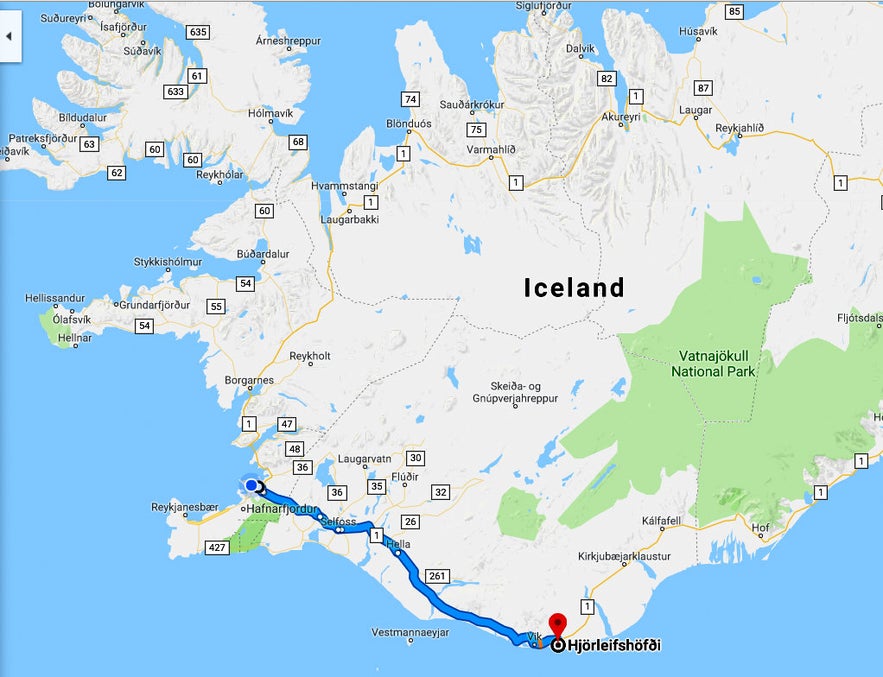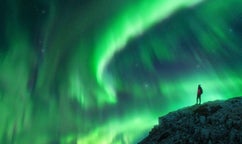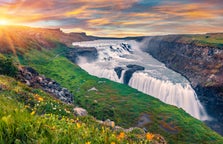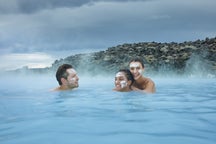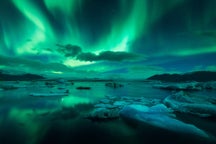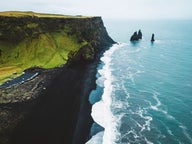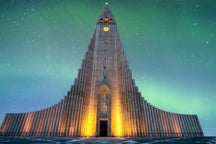
There are some promontories in South Iceland, which are of great interest to me.
One of them is called Hjörleifshöfði promontory. This historical promontory is surrounded by black glacial outwash from the massive volcano Katla and here some tragic events took place.
Hjörleifshöfði is named after the Viking settler, Hjörleifur Hróðmarsson, the blood brother of Ingólfur Arnarson who is considered to have been our first Viking settler in around 874 AD. They arrived in Iceland on two ships, but sadly enough Hjörleifur was killed here in 875 AD, the year after he arrived.
Top photo: Hjörleifshaugur burial mound
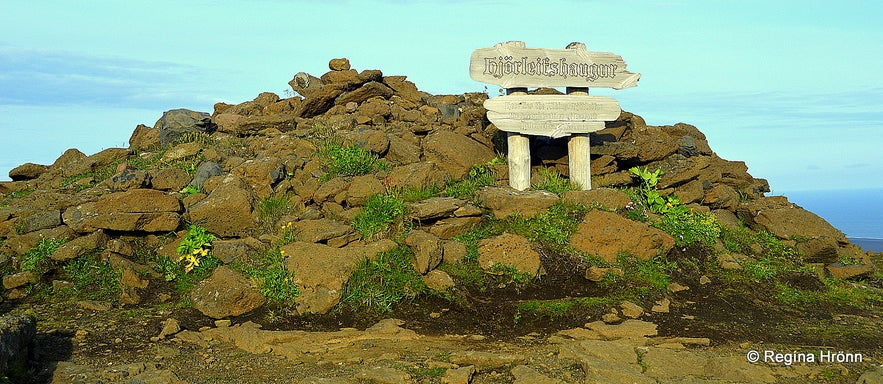
On the highest point of Hjörleifshöfði, you will find the burial mound of Hjörleifur himself - Hjörleifshaugur.
I have already shown you in another travel-blog what the hike up to the top of the promontory is like, who lived there, the hidden people who helped out the inhabitants, and the massive glacial outbursts that took place here when Mt. Katla erupted.
See my travel-blog: Hjörleifshöfði - the Hike, the Inhabitants, and the Yoda Cave.
In this travel-blog I am going to introduce you to the Vikings Ingólfur and Hjörleifur and tell you what Landnáma - the Book of Settlement of Iceland has to say about the first settler of Iceland and his blood brother.
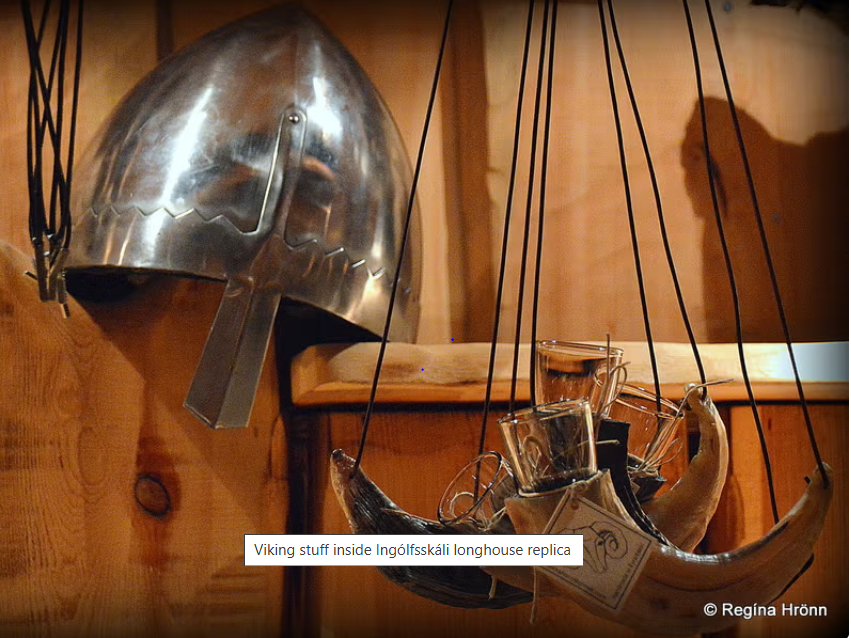
Landnáma was written in the 12th century and the story of Ingólfur and Hjörleifur is told in chapters 3-9.
Landnáma tells us about the bloodline of Ingólfur and Hjörleifur and how they were related. They had the same great-grandfather, Hrómundur Gripsson, so their grandfathers, Björnólfur and Hróaldur were brothers.
Björnólfur had the son Örn, the father of Ingólfur and his sister Helga, but Hróaldur had the son Hróðmar, the father of Leifur (Hjörleifur). Thus the blood brothers Ingólfur and Hjörleifur were second cousins.
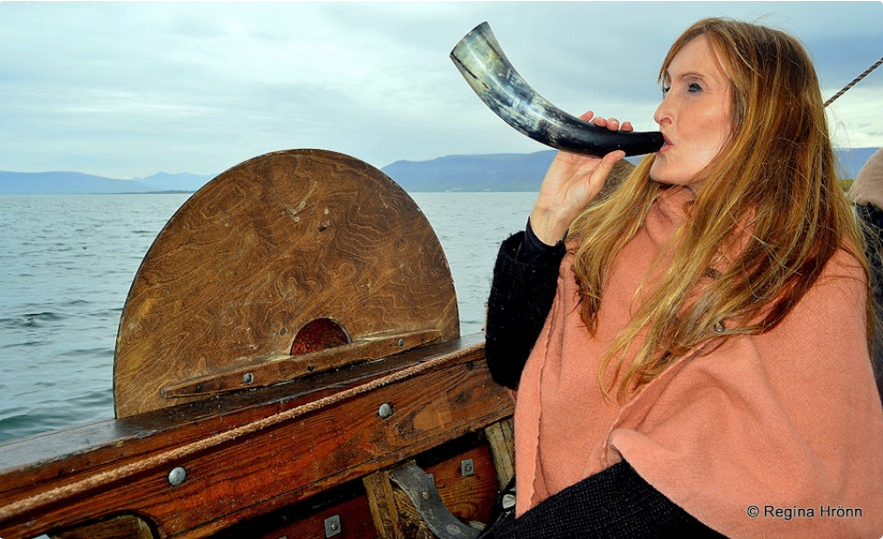
Back in Norway Ingólfur and Leifur went on a Viking raid with the sons of the earl Atli – Hásteinn, Hersteinn, and Hólmsteinn.
They were friends and decided to go on another Viking raid the following year.
That winter Ingólfur and Hjörleifur threw the sons of the earl a feast. At the feast, Hólmsteinn swore that Helga Arnardóttir would become his wife or else he would not marry.
Leifur blushed, seeing that he was in love with his second cousin Helga, the sister of Ingólfur.
 A Viking sword at the National Museum of Iceland
A Viking sword at the National Museum of Iceland
Next spring they meant to go on a Viking raid with the sons of the earl, but Hólmsteinn and his brothers attacked Ingólfur and Leifur, which ended in a Viking battle, where Hólmsteinn was killed.
The next winter the other brother, Hersteinn, attacked them in a battle where Hersteinn got killed.
As a settlement for killing 2 of the earl‘s sons, Ingólfur and Leifur had to give all of their assets to the earl.
(The story is told a bit differently in Flóamanna Saga - there Hásteinn is called Hallsteinn and he ended up having to flee to Iceland. Flóamanna Saga tells his story and the story of his descendants. The Saga of Ingólfur Arnarsson must have been written as well, but if it was then it is lost.).
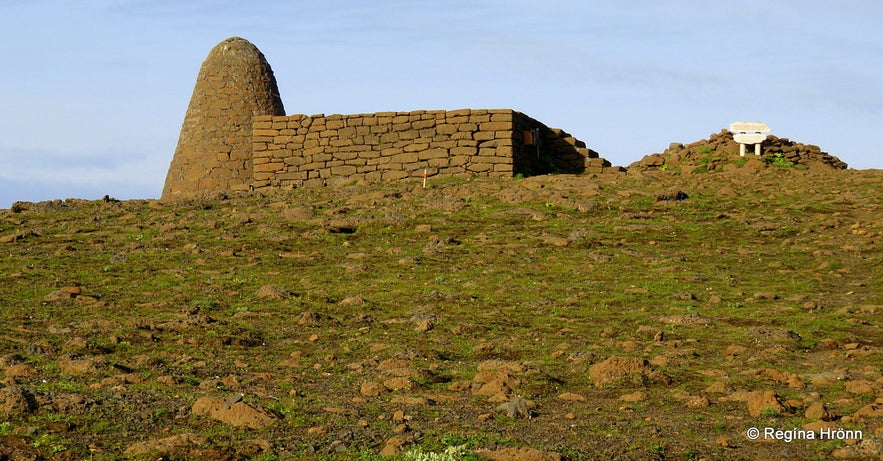
Hjörleifshaugur, the family plot, and a big cairn on top of Hjörleifshöfði
Not owning land any longer the blood brothers went by ship looking for the land found by Hrafna-Flóki, which he had named Ísland-Iceland.
They found Iceland and stayed in the Eastfjords in Álftafjörður for one winter, figuring that the south would be a better place to settle than the north. They then returned to Norway.
Back in Norway Ingólfur saved up money for their emigration to Iceland, but Leifur went on a Viking raid to Ireland.
Leifur raided Ireland and found a large sunken hut. He went into the hut and it was totally dark inside. Then he saw a sword glow in the dark – and a man holding the sword.
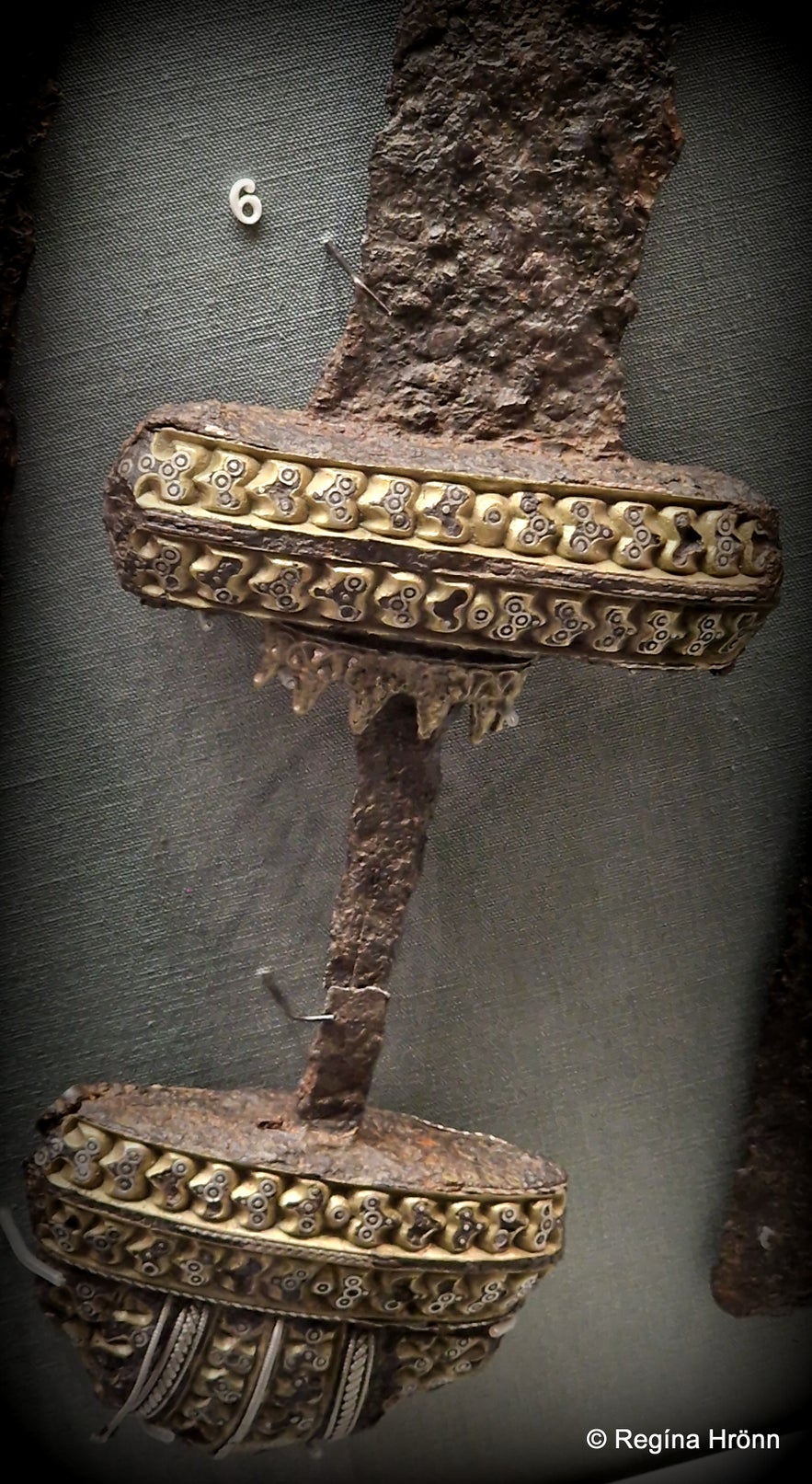 A very decorative Viking sword hinge at the National Museum of Ireland
A very decorative Viking sword hinge at the National Museum of Ireland
Leifur killed the man and took his sword and a lot of money; from that time on he was called Hjörleifur – "hjör" meaning a hinge.
Hjörleifur raided many places in Ireland and acquired a lot of money. He also took 10 slaves and the names of 5 of them are mentioned in Landnáma.
He then returned to Norway to meet up with his blood brother Ingólfur.
Hjörleifur was by now married to Helga Arnardóttir, the sister of Ingólfur, so apart from being blood brothers and second cousins Ingólfur and Hjörleifur were now brothers-in-law.

Hjörleifshöfði cape South Iceland
Ingólfur worshipped the old Nordic gods and sought information about his destiny, whereas Hjörleifur never wanted to worship seeing that he had converted to Christianity.
The oracle told Ingólfur to sail to Iceland.
The brothers-in-law sailed on 2 ships to Iceland. Hjörleifur carried his loot on his ship, but Ingólfur carried their common stock.
They sailed together until they saw Iceland, they then separated.
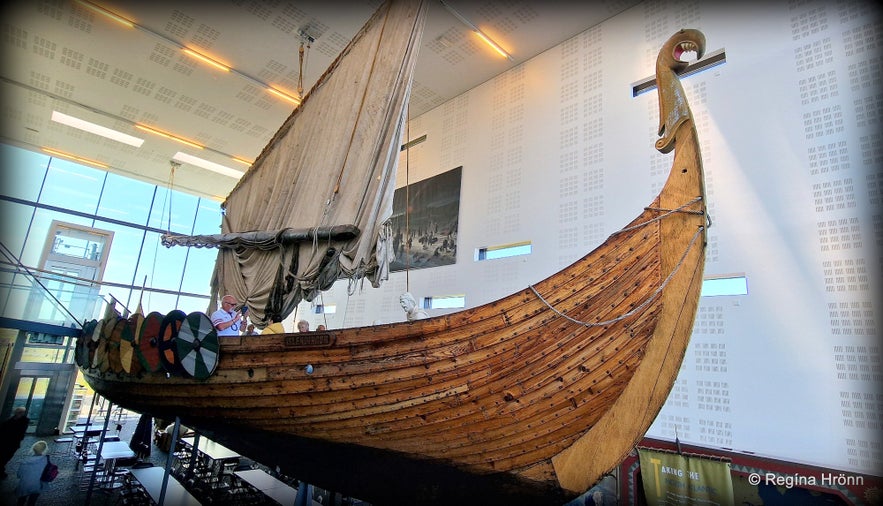 A replica of a Viking ship at the Viking World - Viking Ship Museum in Iceland
A replica of a Viking ship at the Viking World - Viking Ship Museum in Iceland
Ingólfur came ashore by Ingólfshöfði promontory, which got his name, but Hjörleifur came ashore further west by Hjörleifshöfði, which got his name.
At that time there was a fjord by Hjörleifshöfði. Hjörleifur built two farmhouses (huts), one of them 18 fathoms and the other one 19 fathoms.
Here he spent the winter with his workers and Irish slaves and their women.
Next spring he wanted to cultivate the land. He only had one ox so he forced his slaves to pull the plough. This angered the slaves and they killed the ox and blamed it on a brown bear.
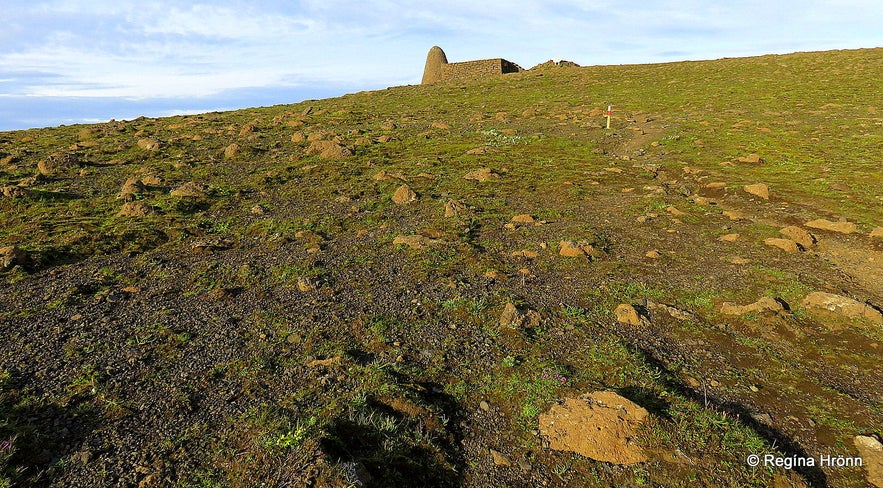
Hiking to the top of Hjörleifshöfði
Seeing that they had just arrived in Iceland and had only stayed here for one winter, they did not know that brown bears don‘t exist in Iceland.
As Hjörleifur and his men went to look for the brown bear in the woods – yes, we had woods back then - the slaves attacked them and killed them all – the men were as many as the slaves.
The slaves then fled with the women and the commodity in a boat to the islands, which can be seen in the south from Hjörleifshöfði, and settled there for a while.

I took this photo at the Saga Museum in Reykjavík - Hallveig and Ingólfur, which I recommend visiting
They knew that the Ingólfur, the blood brother of Hjörleifur, would seek revenge for his death as soon as he were to find out about the killings.
Ingólfur, who was staying at Ingólfshöfði promontory, sent his slaves, Vífill and Karl, to look for his high-seat pillars.
Ingólfur had thrown his high seat pillars from the Viking ship and was going to settle land where the pillars would be found.
When his slaves reached Hjörleifshöfði they found Hjörleifur dead.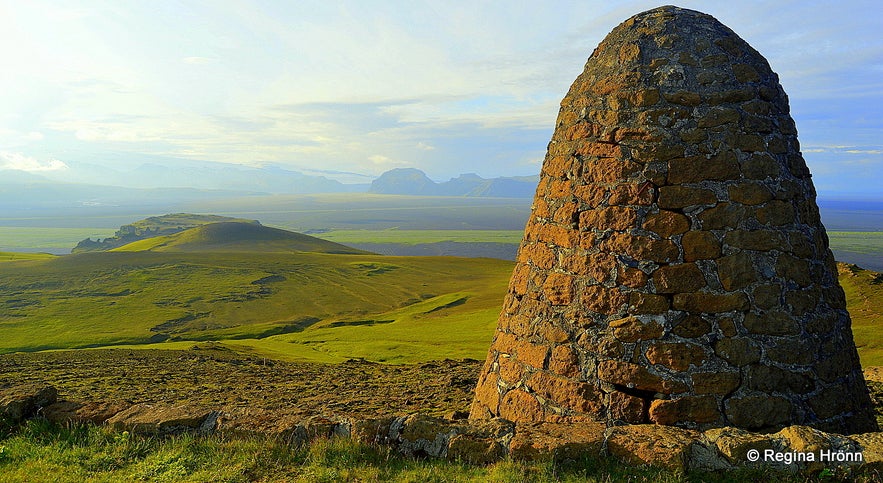
The big cairn on top of Hjörleifshöfði
They went back to Ingólfur to tell him this bad news.
Ingólfur went to Hjörleifshöfði and as he saw Hjörleifur lying there dead he said: "Lítið lagðist hér fyrir góðan dreng, er þrælar skyldu að bana verða, og sé eg svo hverjum verða, ef eigi vill blóta."
Meaning: "What a destiny for a good lad, that he was killed by his slaves. I now see what happens to people who don‘t want to worship the Nordic gods“.
Ingólfur saw to it that Hjörleifur and his men were buried and then hiked up Hjörleifshöfði and saw the islands in the south. 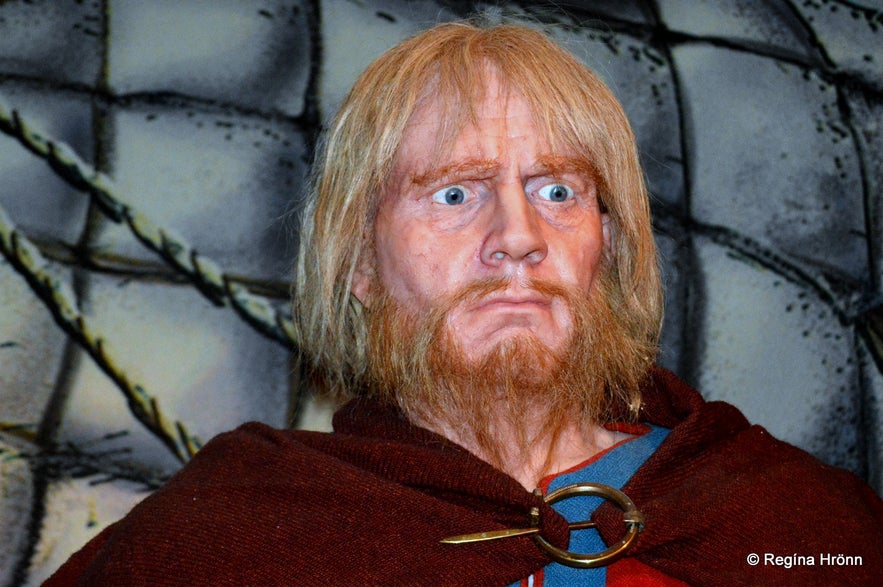
Photo of Ingólfur taken at the Saga Museum
He figured that the slaves might have fled to these islands as the boat was missing.
He sailed with his men to the islands and found the slaves as they were dining.
The slaves panicked and fled, but Ingólfur killed them all. Since then these islands have been called Vestmannaeyjar islands or the Westman Islands as the slaves were Irish or Westmen as they were often called.
In the Westman Islands, you will find one of the largest Puffin nesting areas in the world.
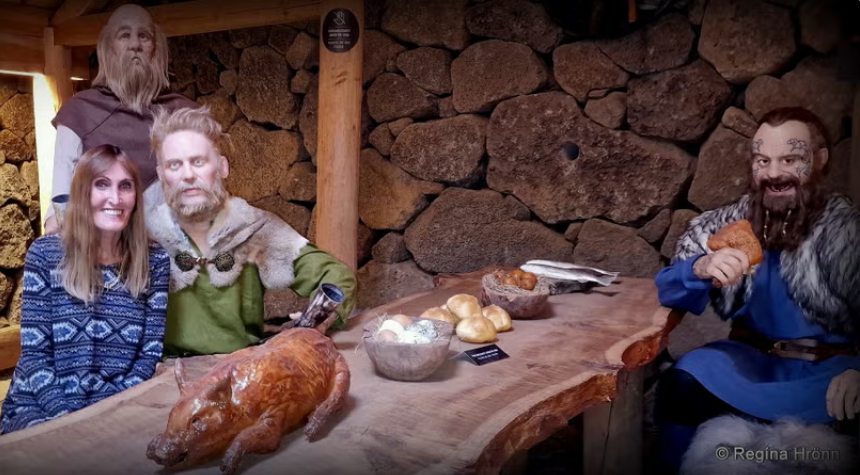
Ingólfur and his men brought with them the wives of the men who had been killed (Hjörleifur and his men) back to Hjörleifshöfði and Ingólfur stayed there for another winter.
The third winter he spent by Mt. Ingólfsfjall, just west of Selfoss and Ölfusá river, and the mountain was named after him.
The slaves of Ingólfur found his high pillars by Arnarhvoll in what is now Reykjavík, the capital city of Iceland, and next spring Ingólfur settled Reykjavík with his wife Hallveig.
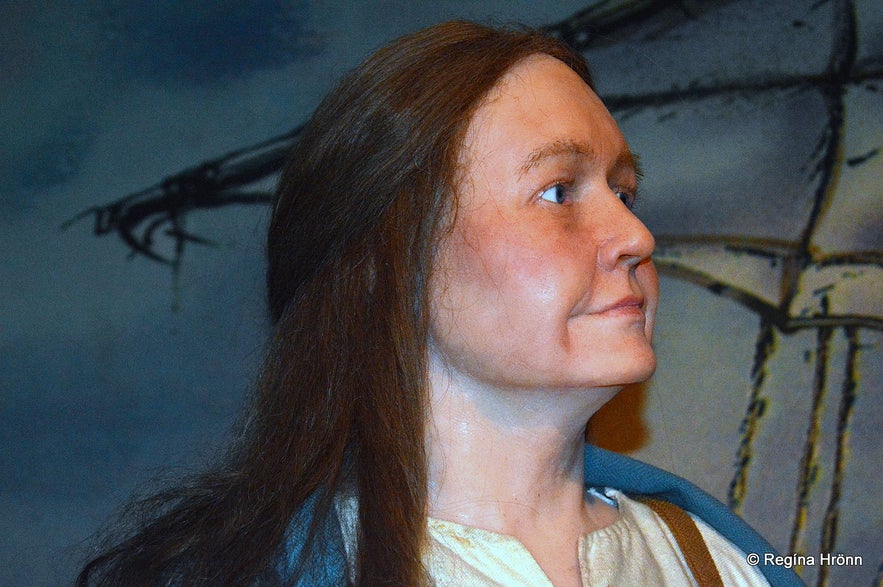
Photo of Hallveig taken at the Saga Museum
In my photos above you will see Ingólfur and Hallveig as they are depicted at the Saga Museum in Reykjavík, which I recommend visiting during your Iceland visit.
After the death of Hjörleifur and his men, "no one dared to settle land there because of supernatural beings".
The Viking who finally settled Hjörleifshöfði promontory was Ölver Eysteinsson, the son of Eysteinn Drangakarl in Fagridalur valley.
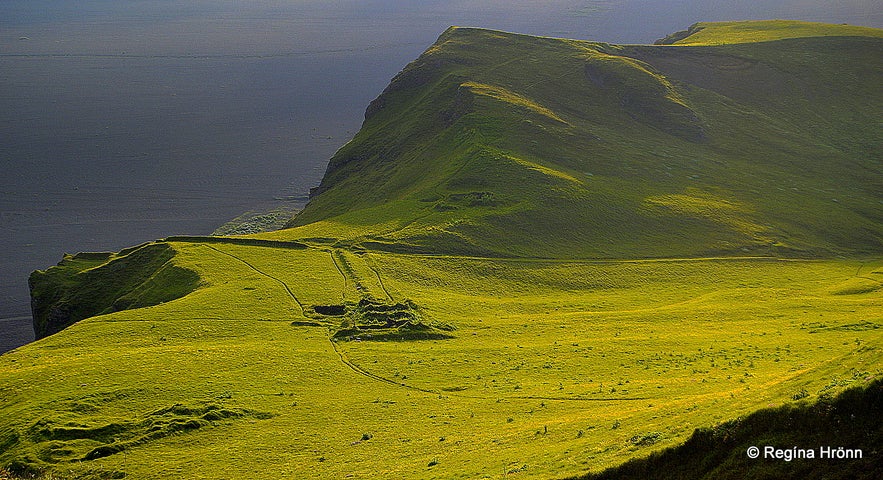
Ruins of the old farm on Hjörleifshöðfi
I found an account in Þjóðsögur Jóns Árnasonar - the Compilation of Folklore of Jón Árnason, which I often refer to in my travel-blogs, and translated it into English:
"By now Mt. Katla had covered the area around Hjörleifshöfði with thick sand, like in other places on Mýrdalssandur sand plains, and destroyed all the traces of human habitation – but now Hjörleifshöfði is a tall mountain.
At the highest peak of Hjörleifshöfði stands a large pile of rocks and on top of it, a cairn has been stacked of rocks. It is believed to be true that beneath the cairn Hjörleifur rests.
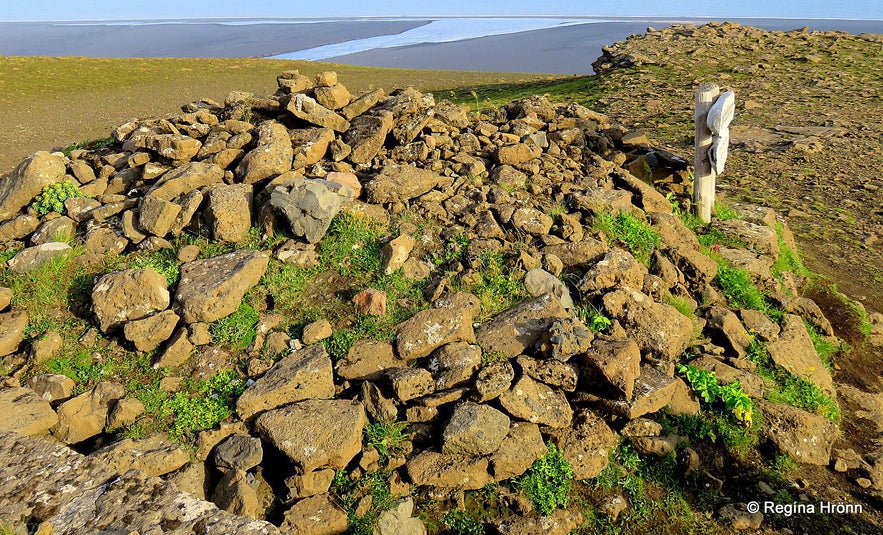
Hjörleifshaugur burial mound
Folklore tells us that a farmer living on Hjörleifshöfði dreamt Hjörleifur, who asked him to move his grave up to the peak of Hjörleifshöfði, where the sun first and last shone.
And where the grave is now, on the highest peak of Hjörleifshöfði, the sun shines first when it comes up and last when it goes down.
Hjörleifur promised the farmer in his dream that he would have luck in his life if he did this for him. This turned out to be true as the farmer had great luck in his life both on land and sea".
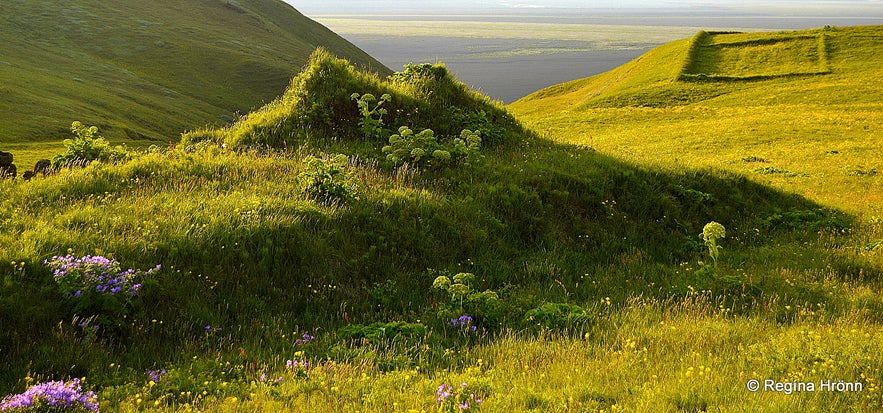
Ruins on Hjörleifshöfði cape
It was a common belief that a spell had been put on Hjörleifshöfði - that whoever lived on it would blossom for 20 years, but after that things would start to go downhill.
It cannot be denied that things have gone exactly this way since the 18th century.
When a new farmer had come to live in Hjörleifshöfði and had added to the cairn and looked after it, almost always he had luck shortly after.
On the other hand, when a farmer had been over 20 years in Hjörleifshöfði and a stone was added to the cairn, the farmer lost one of his cattle or at least one of his domestic animals.

Signs by Hjörleifshöfði
Benedikt Þórðarson, who later drowned in Mýrdalssandur, once came to Hjörleifshöfði in heavy snow and knew exactly where he was going.
But when he had hiked up Hjörleifshöfði and was heading for the farm he all of a sudden got lost and found himself by Hjörleifsleiði burial mound - which is much higher up than the old farm.
He meant to head in the direction of the farm from the burial mound, but he soon got lost again and didn't know where he was going until he was back at the burial mound; it went like this three times.
Then Benedikt wrote 3 verses, 2 of which are now lost, but the first one goes like this:
„Er hér haugur uppgjörður,
ýtar hafa í minni,
hér var grafinn Hjörleifur
hraustur í fornöldinni.“
Which translates into English something like this:
A burial mound has been rebuilt here,
Men will remember
Here was buried Hjörleifur
A valiant man from antiquity."
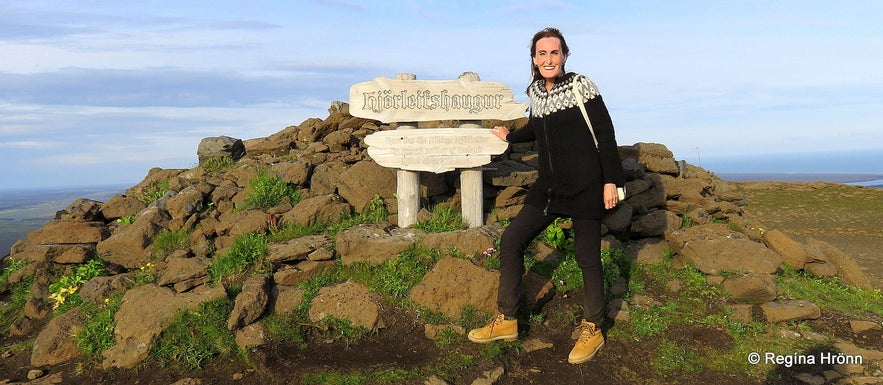
Hjörleifshaugur burial mound
Haraldur hárfagri - Haraldur Fairhair had been the king of Norway for 12 years when Ingólfur and Hjörleifur left Norway to settle in Iceland.
Many more Norwegians fled the dictatorship of Harald later on and became settlers in Iceland.
Ingólfur is the best-known Viking settler as he was the first Norwegian to settle in Iceland - he settled in Reykjavík, which was later to become Iceland's capital city.
Many Norwegian Vikings followed in his footsteps and settled in other parts of Iceland.

The statue of Ingólfur Arnarson in Reykjavík
I have told you about these Viking settlers in other travel-blogs. F.ex. Gísli Súrsson the Outlaw.
Their story, which has been written in both the Book of Settlement and our Icelandic Sagas, is very colourful and sometimes very bloody.
I have written another travel-blog about the bloody Viking battles in Skagafjörður when the biggest Viking clans of Iceland fought each other.
Ingólfur Arnarson (844) and Hallveig Fróðadóttir (850) are my ancestors and I am the 30th generation from them.
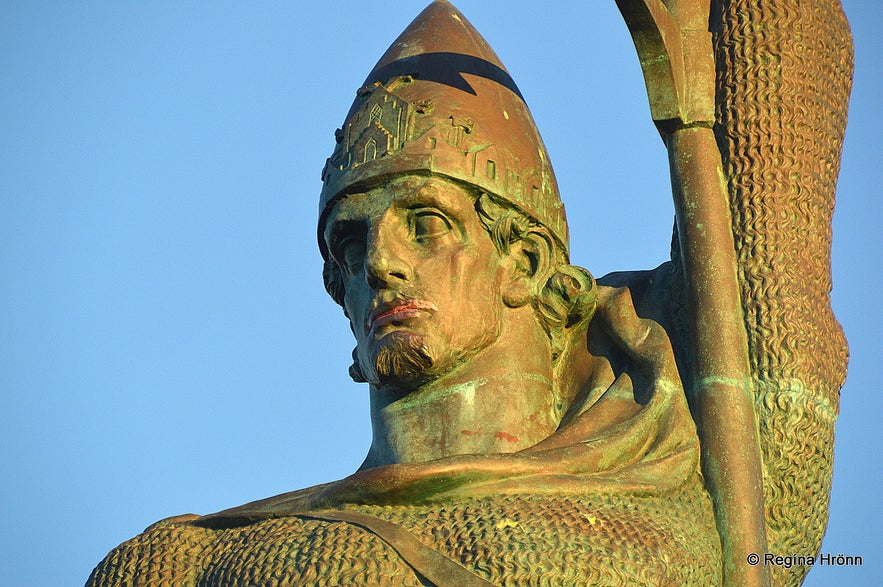
The statue of Ingólfur Arnarson in Reykjavík
Isn't this an interesting story about a promontory most people pass on their way to other better-known sights in South Iceland?
We pass by many interesting sights if we don't know their story, so I am going to tell you as many stories as I possibly can about interesting places to visit in Iceland.
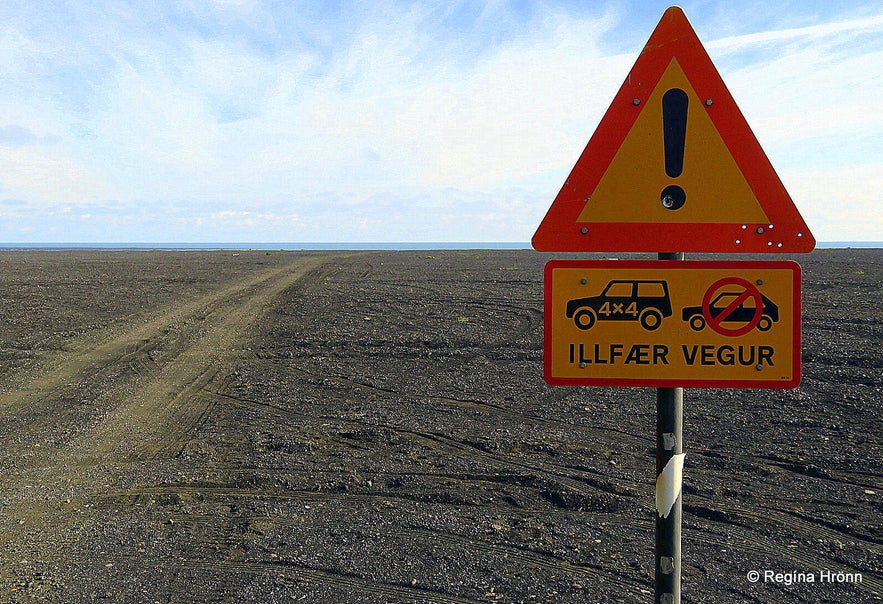
From Hjörleifshöfði you can drive down to the southernmost point of the mainland of Iceland, Kötlutangi spit.
I have written 2 travel-blogs about Hjörleifshöfði and in my second part Hjörleifshöfði in South Iceland - the Hike, the Inhabitants and the Yoda Cave, you will learn more about the people who inhabited Hjörleifshöfði, their grave on the highest peak next to Hjörleifshaugur burial mound, the monument on this peek in the liking of a big cairn, built by Danish surveyors in the first decade of the twentieth century - and my hike on the promontory.
Hjörleifshöfði is on the coast of South Iceland, on Mýrdalssandur beach, just east of the village of Vík.
From Vík, drive along ring-road 1, then turn onto the road marked Hjörleifshöfði.
Hjörleifshöfði was for sale from 2016 and in 2020 it was sold. The land reaches up to the glacier and Mt. Hafursey. I wished that my country would have bought this historic cape, but a foreign company bought it.
A company called Viking Park operates in this area. Check them out on Facebook and on their website.
You are now obliged to pay for parking by Hjörleifshöfði, and the fee goes to the maintenance of this area.
Here is the location of Hjörleifshöfði on the map. GPS: 63°25'13.2"N 18°44'58.0"W
I have written another travel-blog that might be of interest to you about Viking Ruins and Burial Mounds I have visited on my Travels in Iceland - which is a list of all the archaeological sites and burial mounds, that I have visited in Iceland.
And another travel-blog about: The Viking Settler Ingólfur Arnarson, Mt. Ingólfsfjall, and Ingólfsskáli Turf Longhouse in South Iceland if you want to know more about Ingólfur Arnarsson.
Have a lovely time in Iceland :)


